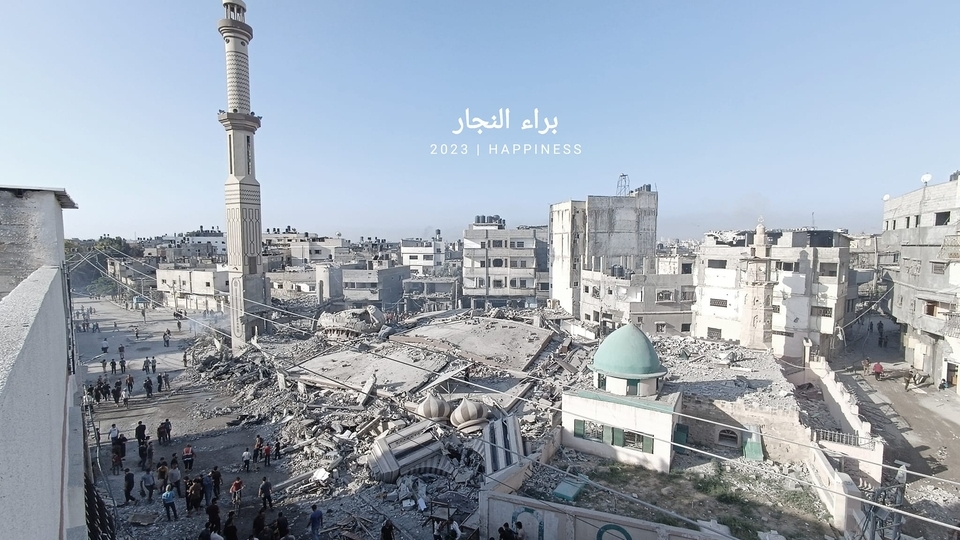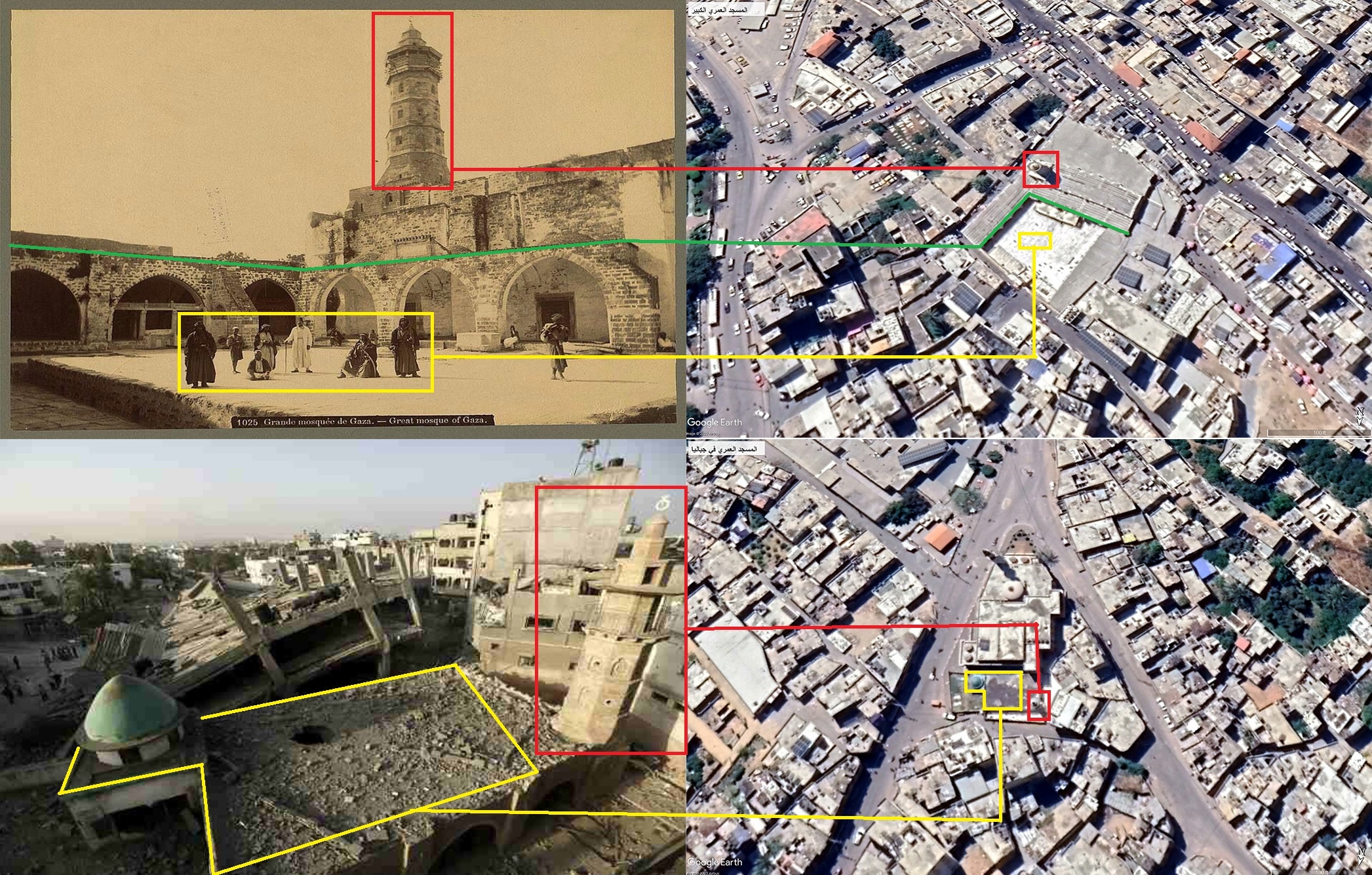The Tale of Gaza’s al-Omari Mosque and the Erasure of Palestinian Archaeological Heritage
Editor's Note: This is one of several open-source intelligence (OSINT) investigations conducted by the NAWA Media Open-Source Investigations Team in collaboration with journalists at The Public Source. These reports were produced in October and November of last year; due to the rapidly escalating violence, the figures are a historical record of that time rather than a reflection of the current reality. Through these reports, we aim to contribute to the growing body of evidence of war crimes and crimes against humanity committed by Israel in its war against the Palestinian people in Gaza. For this reason, the authors of these investigations use precise and cautious language that helps in advancing the prosecution of these crimes in international courts.
There are growing concerns about the impact of Israeli military operations in Gaza on Palestinian cultural and historical heritage. These operations, which started in early October 2023 and are ongoing, have killed more than ten thousand civilians up until the time of writing this report [editor’s note: early November 2023]. A total of 4,237 children, 2,719 women and 631 elderly have been killed. These concerns are rising considering the targeting of museums, churches, and mosques. The government media office in Gaza reported in early November 2023 that the Israeli military completely destroyed 56 mosques, and damaged 136 mosques and 3 churches, since the start of military operations on October 7, 2023.
This investigation analyzes the targeting of the Al-Omari Mosque in Jabalia, an important historical site which dates back to the Middle Ages. Sources state that the mosque was bombed on the morning of Friday, October 20, destroying it almost completely except for its minaret which remained standing. However, the minaret was bombed three days later, according to social media, completing the destruction of the entire mosque. This investigation also aims to clarify the confusion created by some media outlets mistakenly referring to the Great Omari Mosque in the Daraj Quarter, rather than the Al-Omari Mosque in Jabalia, as the location of the attack. We seek to correct the record by providing precise details and analysis of the open-source information about the attack.
About the Targeted Mosque
The Al-Omari Mosque, located in Jabalia, was one of the most prominent Islamic landmarks in the northern Gaza Strip. The mosque, referenced in the archaeological guide “Gaza… Gate to the Levant,” had a rich history dating back to the Mamluk era. Its octagonal minaret was distinguished by its decorative elements which highlighted its architectural and cultural importance. The mosque was recently completely destroyed. This investigation analyzes the attacks on this mosque.
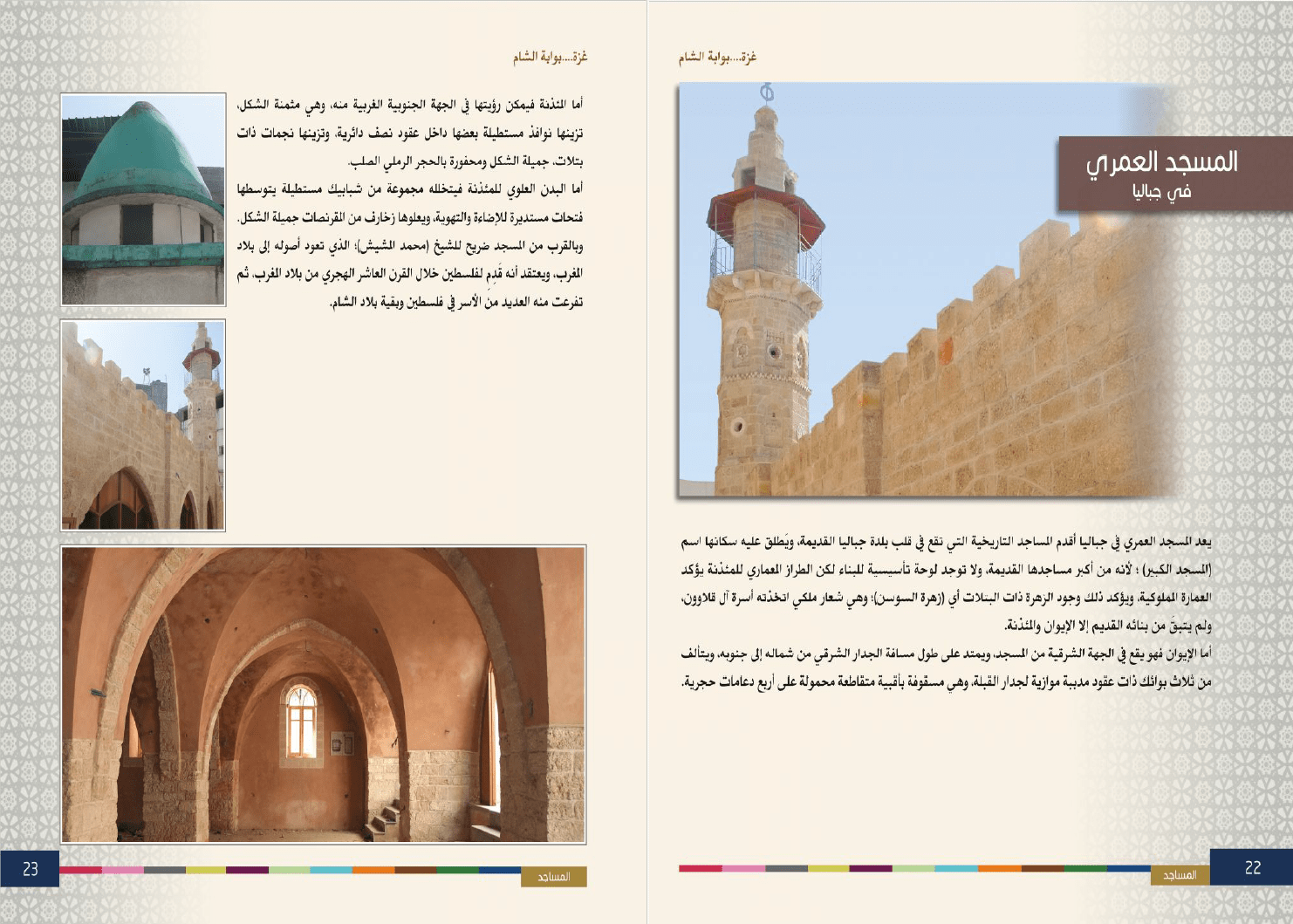
An image from the archeological guide, Gaza… Gate to the Levant, containing information about the Al-Omari Mosque in Jabalia.
Geolocating the Mosque
By reviewing satellite images and other images shared by activists on social media, it was possible to confirm the exact location of the Al-Omari Mosque in Jabalia. The mosque was severely damaged as shown in images. The map below clearly shows the location of the mosque and the extent of its destruction.
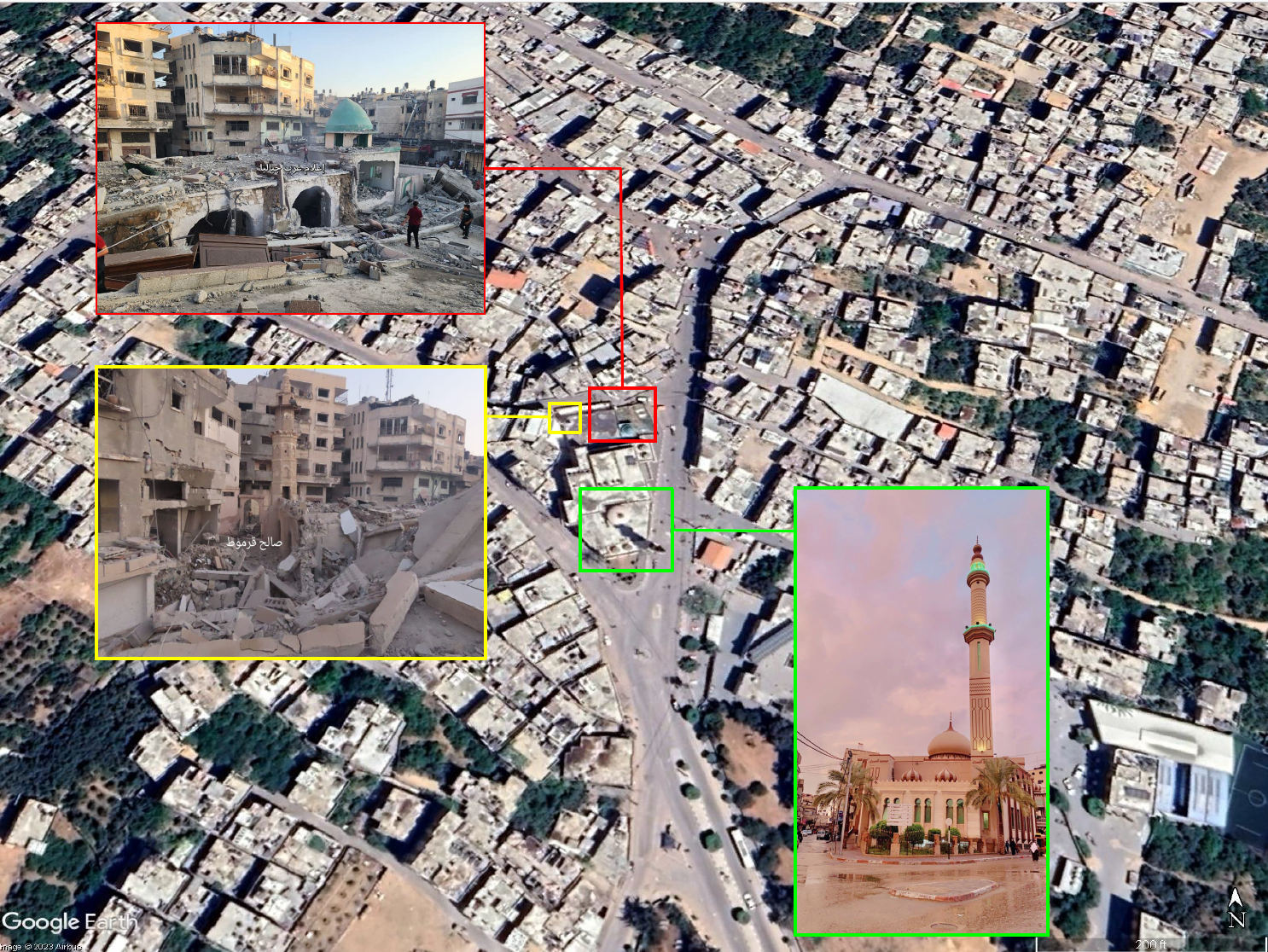
A composite map showing the location of the Al-Omari mosque in Jabalia, Gaza, containing satellite imagery, an image of the mosque before the October 20 attack, and two images of the destruction after.
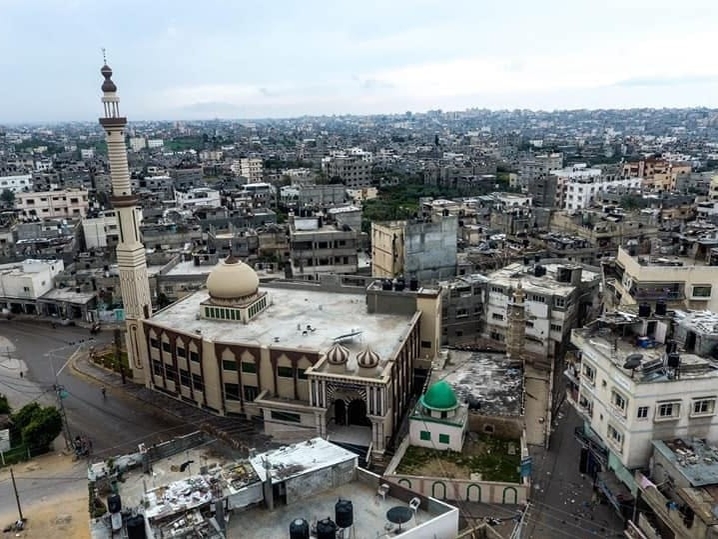
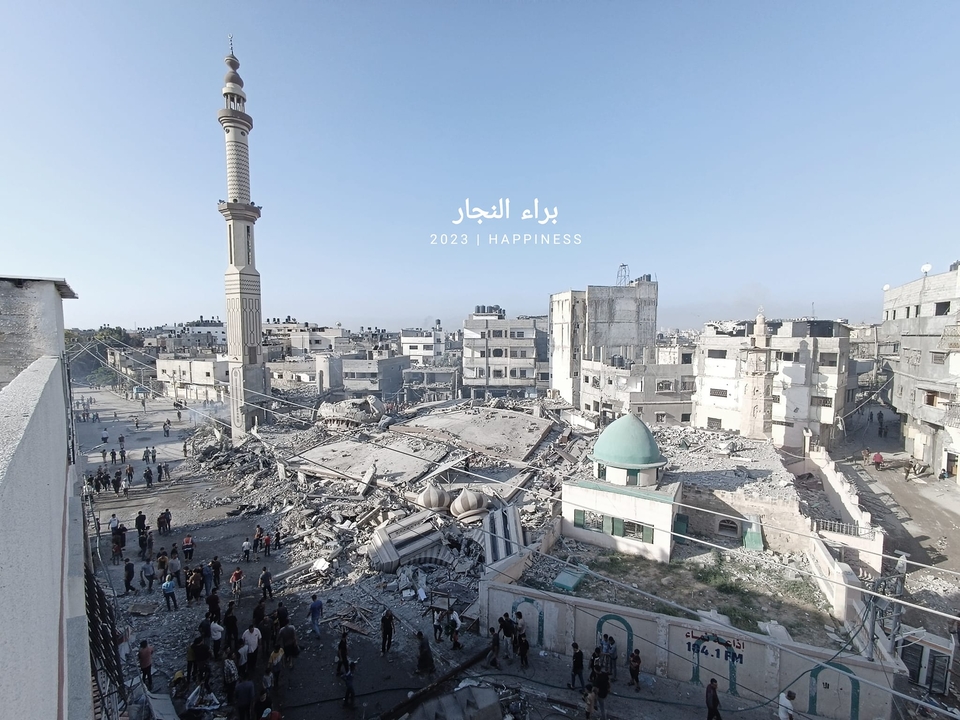
The photo on the left shows the Al-Omari mosque in Jabalia, Gaza. The photo on the right shows the mosque, destroyed. The former photo was taken from Al Falah; the latter photo was taken by Baraa Al-Najjar and published on Facebook on October 20, 2023.
The First Attack on the Mosque
Since October 7, Israeli occupation forces have used varied military operations to escalate tensions in the Gaza Strip; reports of Israeli occupation forces targeting religious landmarks have since emerged. On Friday, October 20, at 2:48, the “Jabalia Now” Telegram channel published the first report of the attack on the Al-Omari Mosque. The Palestinian Ministry of Interior then shared the news on its Telegram channel at 3:05. Afterwards, news websites such as Anadolu Agency reported at 3:31 that Israeli airstrikes destroyed the mosque.

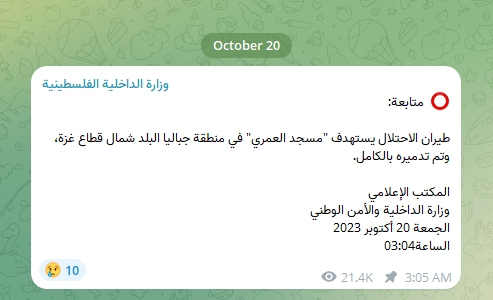
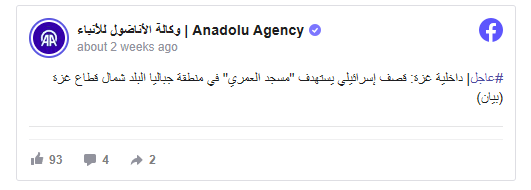
Screenshots of the first reports of the attack by Jabalia Now on Telegram, the Palestinian Ministry of Interior on Telegram, and Anadolu Agency on Facebook.
That same morning at 8:10, activist Muhammad Farah shared photos on his Facebook account documenting the damage to Al-Omari Mosque that resulted from the bombing that targeted the area. The photos, which were taken at sunrise, show the extent of the destruction of the mosque. Shortly after, at 8:58, the “Jabalia Now” Telegram channel shared another set of photos giving a clearer view of the severity of the damage to Al-Omari Mosque.
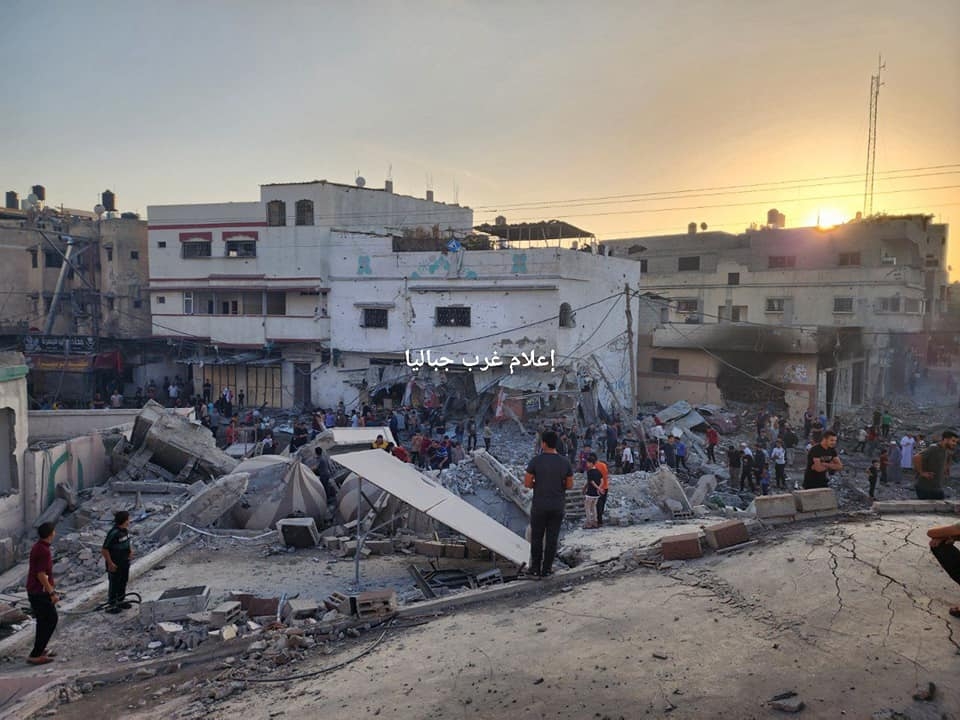
An image from a Facebook album of the first moments after the attack.
Temporal and Geographical Verification of Images
As part of the investigation, we conducted temporal and spatial verification of the circulated photos, which show the destruction of Al-Omari Mosque in Jabalia. We used satellite images and geographic analysis to locate the exact location of the mosque and used surrounding landmarks as references. In addition, we analyzed the position of the sun in the images and compared them to the sun position and path data for Jabalia from SunCalc to estimate the time at which the images were taken. The sunrise in Gaza that day was recorded at 6:23. Using this information, we estimated that the images showing the damage were taken approximately one hour after sunrise, at around 7:30. The images show the position of the sun at a location that matches the estimated time it was taken, which supports the accuracy of the time data for the incident.
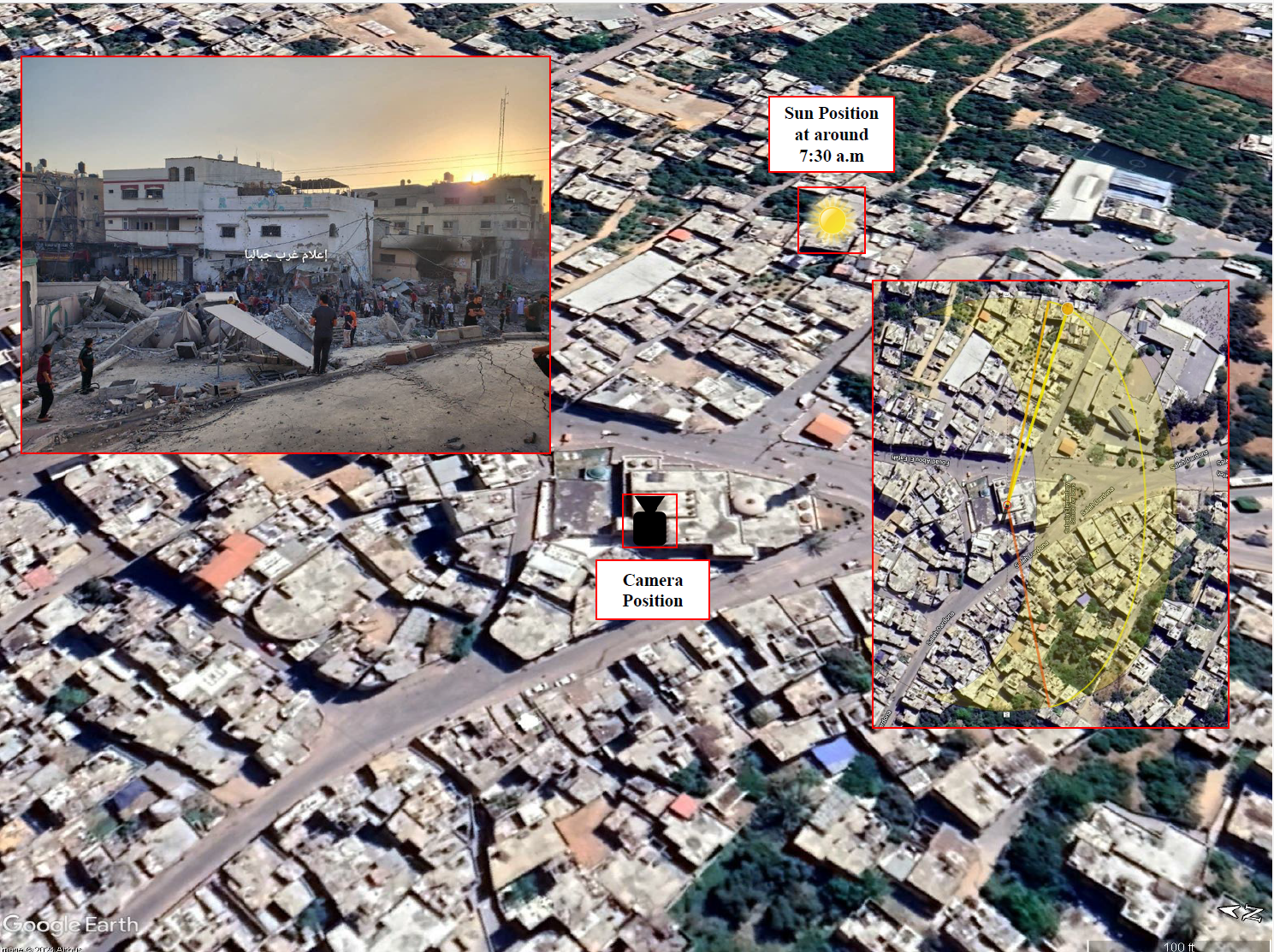
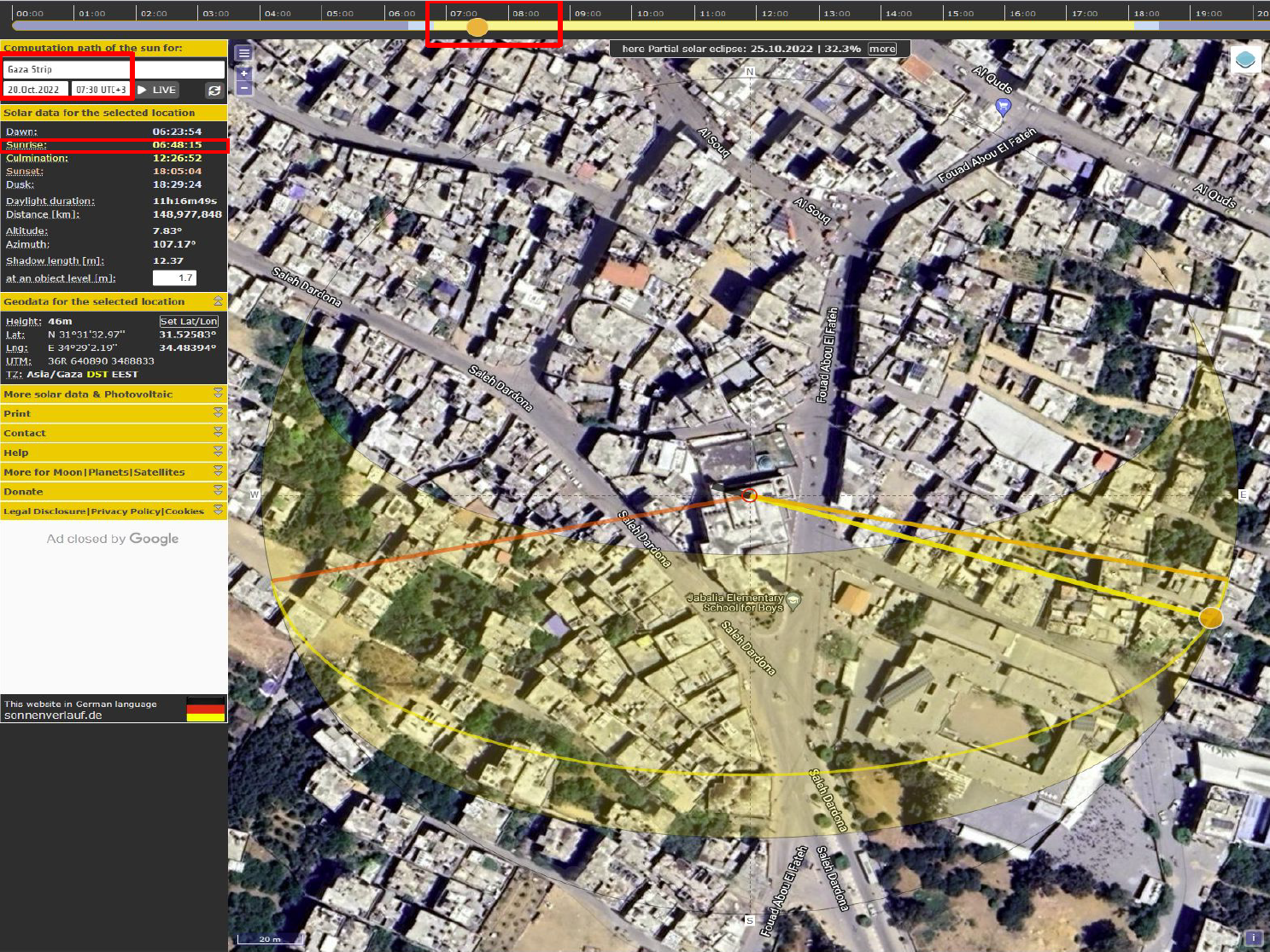
Images from SunCalc showing the position and path of the sun at the mosque site at approximately 7:30 on the date of the attack, October 20, 2023.
At 8:28, Ibrahim Al-Harthani posted a video on Facebook showing the destruction of Al-Omari Mosque. This video is believed to be the first to document the events after the bombing. At 10:08, Muhammad Al-Najjar shared another video on Facebook, showing the total destruction of the entire mosque premises, including its distinctive green dome.
On October 21, 2023, the day after the incident, Talla Rim shared a video on Facebook documenting the damage to homes surrounding the mosque. A comment by the video’s narrator praised the steadfastness of the minaret, which remained standing despite the bombing. This was reflected in photos of the mosque that circulated after the attack.
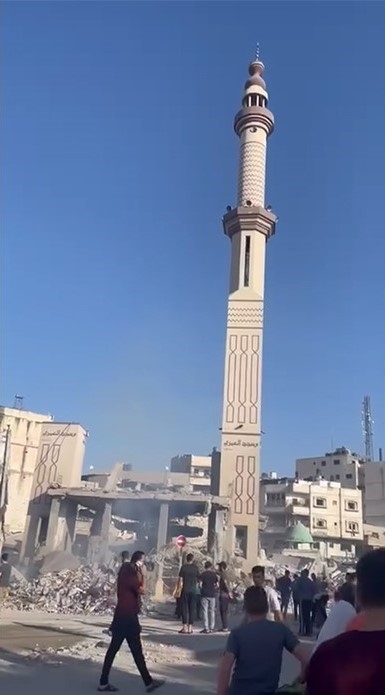
A screenshot from a video published on Facebook by Talla Rim on October 21, 2023, the day after the incident, showing the mosque and surrounding damage.
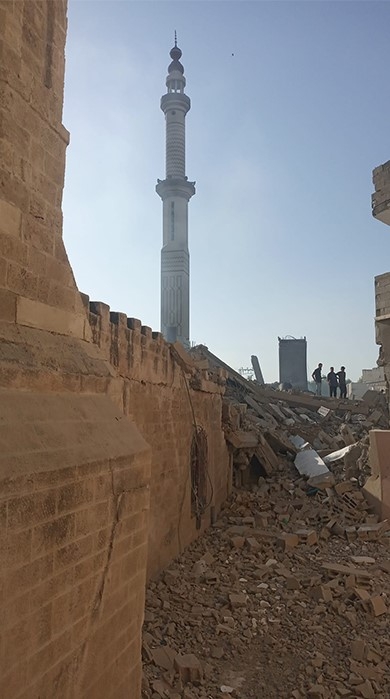
A photo published by Issa Shehab on Facebook on October 20, 2023 showing the minaret of Al-Omari Mosque. The minaret was not impacted by the first attack.
The Second Attack
At 16:32 on October 23, 2023, three days after the first attack on the Al-Omari Mosque, the “Jabalia Now” Telegram channel reported that an Israeli aircraft carried out a new raid targeting the minaret of the Al-Omari Mosque. According to the source, the minaret remained in place after the first bombing on October 20. At 17:06 on October 23, about half an hour after the “Jabalia Now” report, the Al-Ra’i Agency published a photo on Telegram showing that the minaret had finally collapsed, turning the mosque into a pile of rubble. The agency reported that this second attack killed and wounded Palestinian victims.
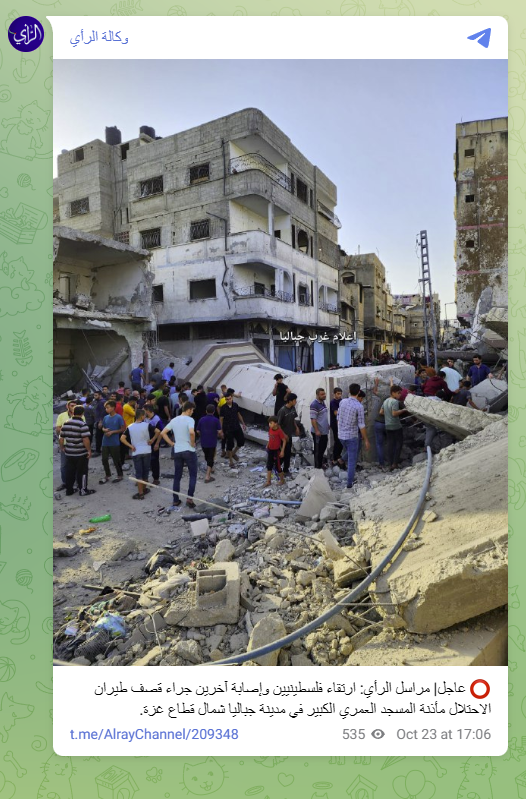
The message from the "Jabalia Now" Telegram channel reporting another attack on the Al-Omari mosque, three days after the first attack on October 20, 2023.
Hours after the airstrike on the minaret, Sama News Agency issued a statement on Telegram identifying some of the victims of the attack. According to the statement, Muhammad Yasser Dardouna and his son were identified as victims whose bodies were recovered from under the rubble. The agency did not publish the names or conditions of the wounded in this Israeli raid.

A message on Sama News Agency's Telegram channel identifying some of the victims of the second attack on the Al-Omari mosque, including Muhammad Yasser Dardouna and his son.
Damage Analysis Based on the Review of Circulated Images and Videos
Following careful analysis of images and videos, the data shows the extent of the destruction of Al-Omari Mosque in Jabalia. The photos clearly show that the mosque was completely destroyed. Neighboring buildings were also damaged, with residential and commercial structures showing signs of heavy bombing. The scattered debris indicates the strength of the explosions, and the gathering of residents around the rubble shows the extent of the psychological and social impact of the attack.
Satellite images show precise documentation of the situation before and after the attack on the Al-Omari Mosque in Jabalia. The photo taken on October 17, 2023, shows the mosque before the accident, in its usual undamaged condition. The photo taken on October 21 shows the destruction of the mosque, supporting the published evidence and photos that indicate the attack occurred on October 20. This visual analysis is a key step in the series of investigative procedures undertaken and contributes to confirmation of the reported events related to the attack on the Al-Omari Mosque in Jabalia.
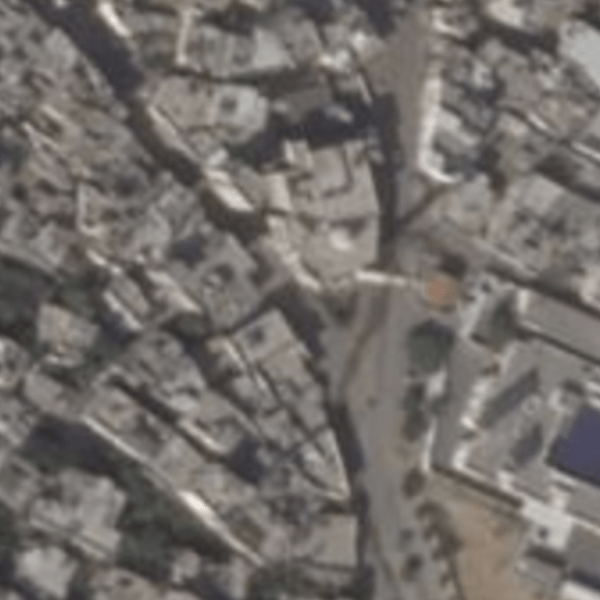
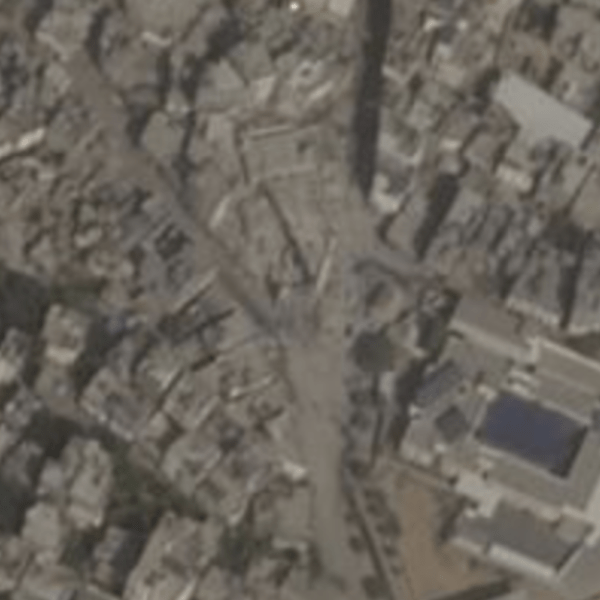
The photo on the left shows the Al-Omari mosque in Jabalia before the attack; it was taken on October 17, 2023. The photo on the right shows the destroyed mosque; it was taken on October 21, 2023.
Correcting the Accounts
Misleading news and disinformation often circulate on the internet and lead to confusion around developments in Israeli military operations happening on the ground in Gaza. In the case of the Al-Omari Mosque in Jabalia, false information spread across social media platforms where some believed that it was the Great Omari Mosque in the Daraj Quarter of the Old City in Gaza that had been bombed. These claims were accompanied by photos of the Great Omari Mosque. Given this confusion, it is crucial to emphasize that the Great Omari Mosque in the Daraj Quarter is a completely different mosque from the Al-Omari Mosque that was attacked in Jabalia. Both mosques have historical value, and it is believed that the targeted Al-Omari Mosque in Jabalia dates back to the Mamluk era.
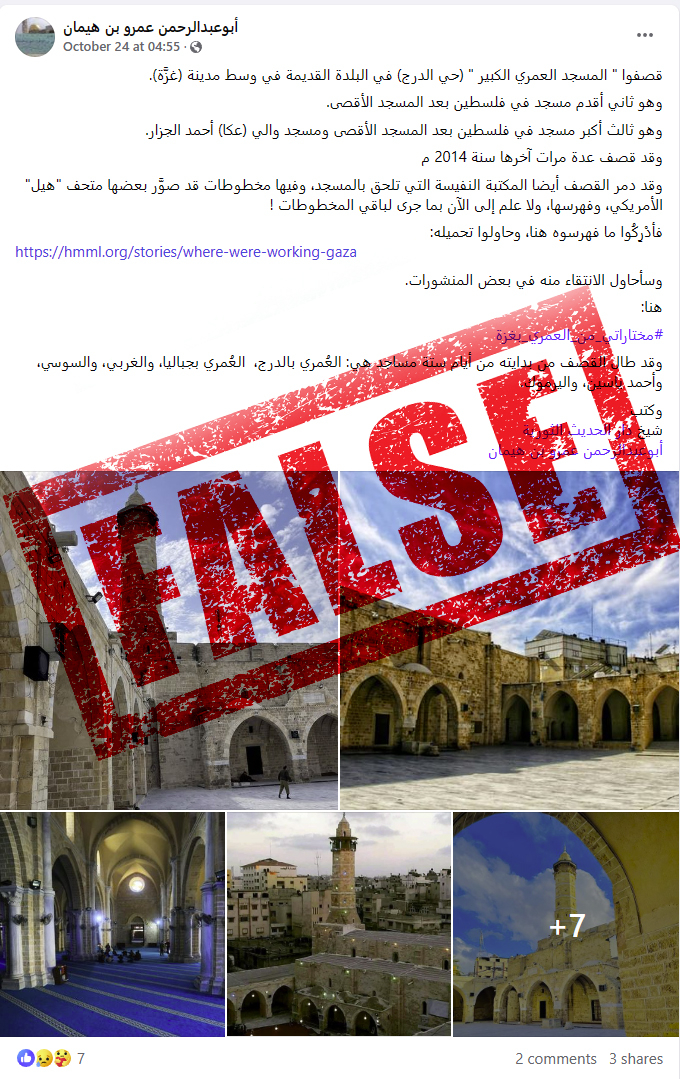
A Facebook post published on October 24, 2023 incorrectly stating that it was the Great Omari mosque in the Daraj Quarter of Gaza's Old City that was bombed.
Confusion and dissemination of false information were not only shared by users of social media, but also by some news websites, which contributed to the spread of false news. For example, Megaphone News posted on X (formerly Twitter) that the Israeli state bombed the Grand Omari Mosque, and in the same post shared an illustration that contained incorrect geographical and identifying information. The illustration showed the mosque’s location in the Daraj Quarter and linked it to Al-Omari Mosque in Jabalia. This error highlights the importance of verifying sources and checking facts before publishing information, especially in the context of conflicts.
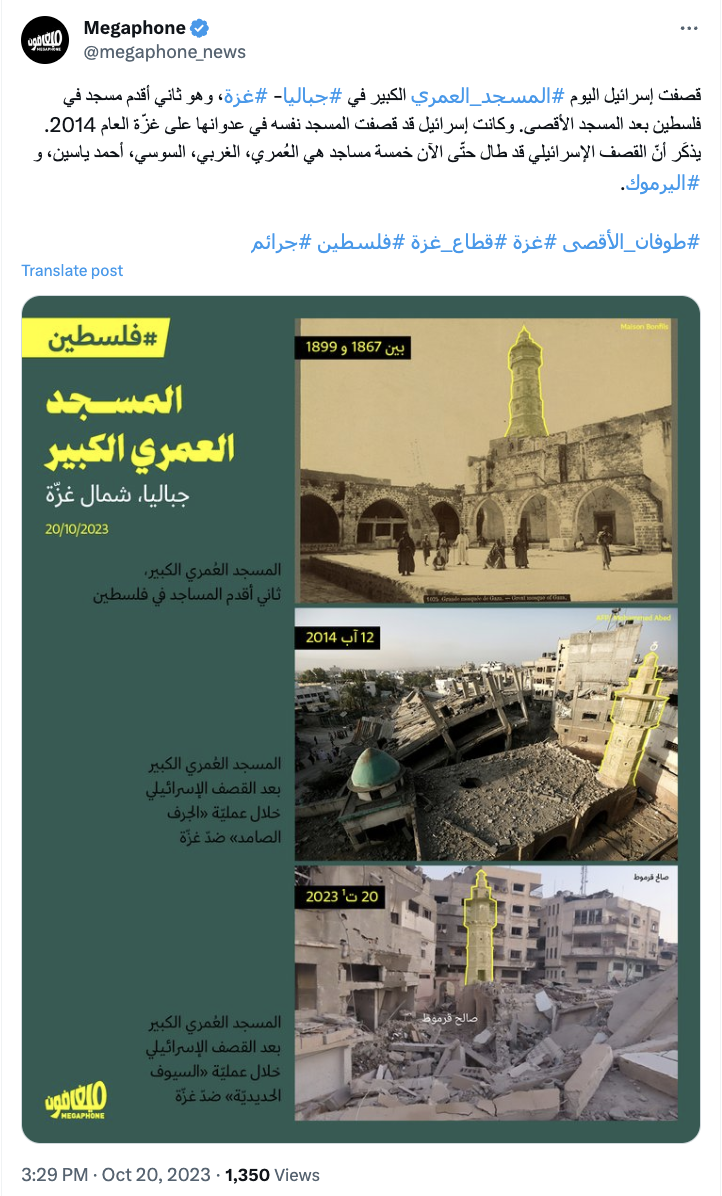
The Megaphone News post on X (formerly Twitter) stating that the Israeli state bombed the Grand Omari mosque — and sharing an illustration that contains incorrect geographical and identifying information — when it was the Al-Omari mosque that was attacked.
While we were conducting the investigation, we did not find any visual evidence confirming that the Great Omari Mosque in the Daraj Quarter in Gaza City had been targeted. The focus of the investigation remains limited to events related to the Al-Omari Mosque in Jabalia, north of Gaza City, where the attacks and their impact on this historic site have been documented.
Past Attacks
Investigations indicate that the bombings of Al-Omari Mosque in Jabalia on October 20 and 23, 2023 were not the first of their kind. Records document that the mosque had been targeted in the past, including on August 20, 2014, when the mosque was hit by Israeli airstrikes that resulted in vast destruction as the visual archive shows. The raid on that day also killed the mosque’s muezzin and injured several people. The oldest visual documentation of the mosque which was found on Facebook dates back to 2013, showing the mosque before it was hit by that series of attacks.
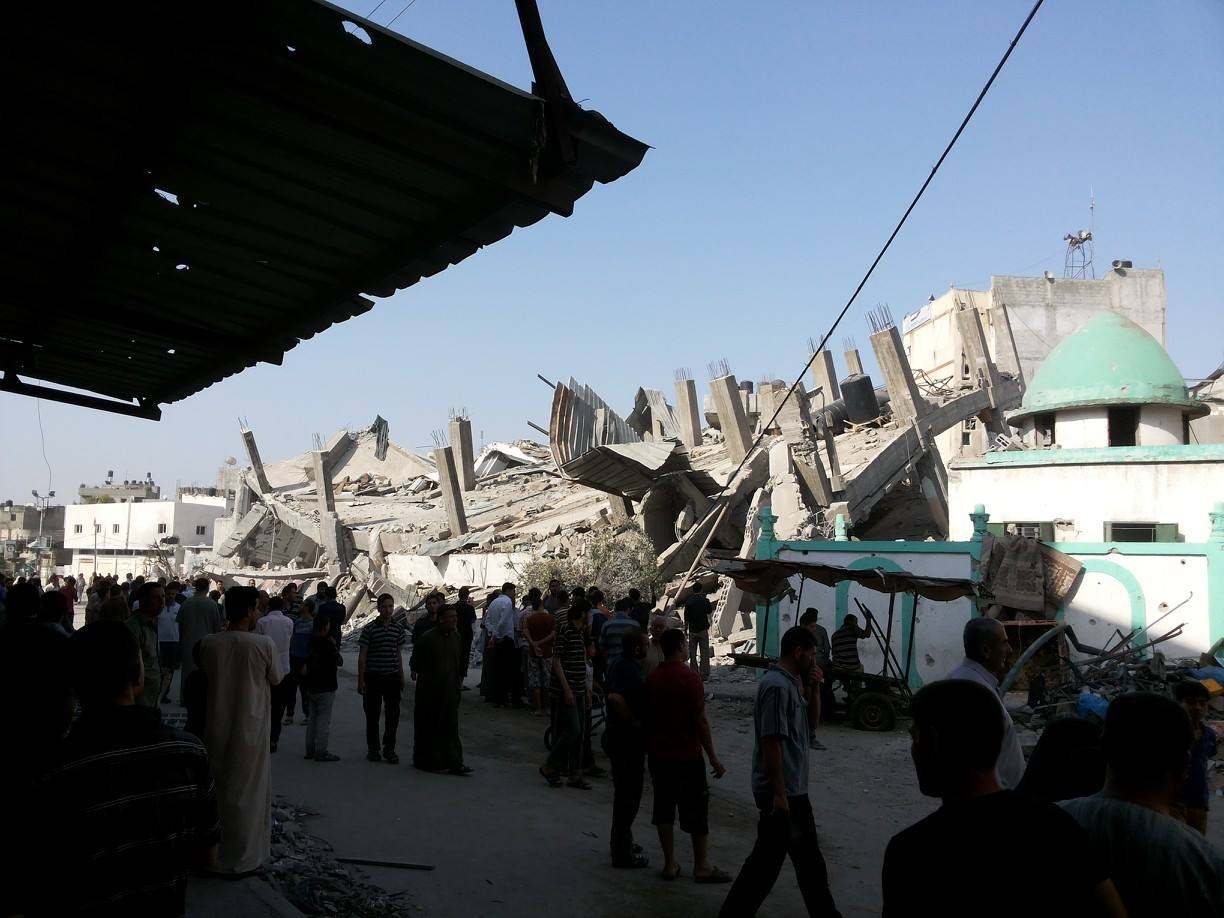
A photo published by Ashraf Alashqar on Facebook shows the destruction of Al-Omari Mosque in Jabalia by the Israeli raid which occurred on August 2, 2014.
Rebuilding the Mosque
In 2015, one year after the raids on Al-Omari Mosque, some of the residents in the area started a self-financed initiative to repair and restore parts of the mosque’s facilities that were damaged. Despite these efforts, the main part of the mosque remained in ruins and abandoned, and its doors closed to worshippers for many years.
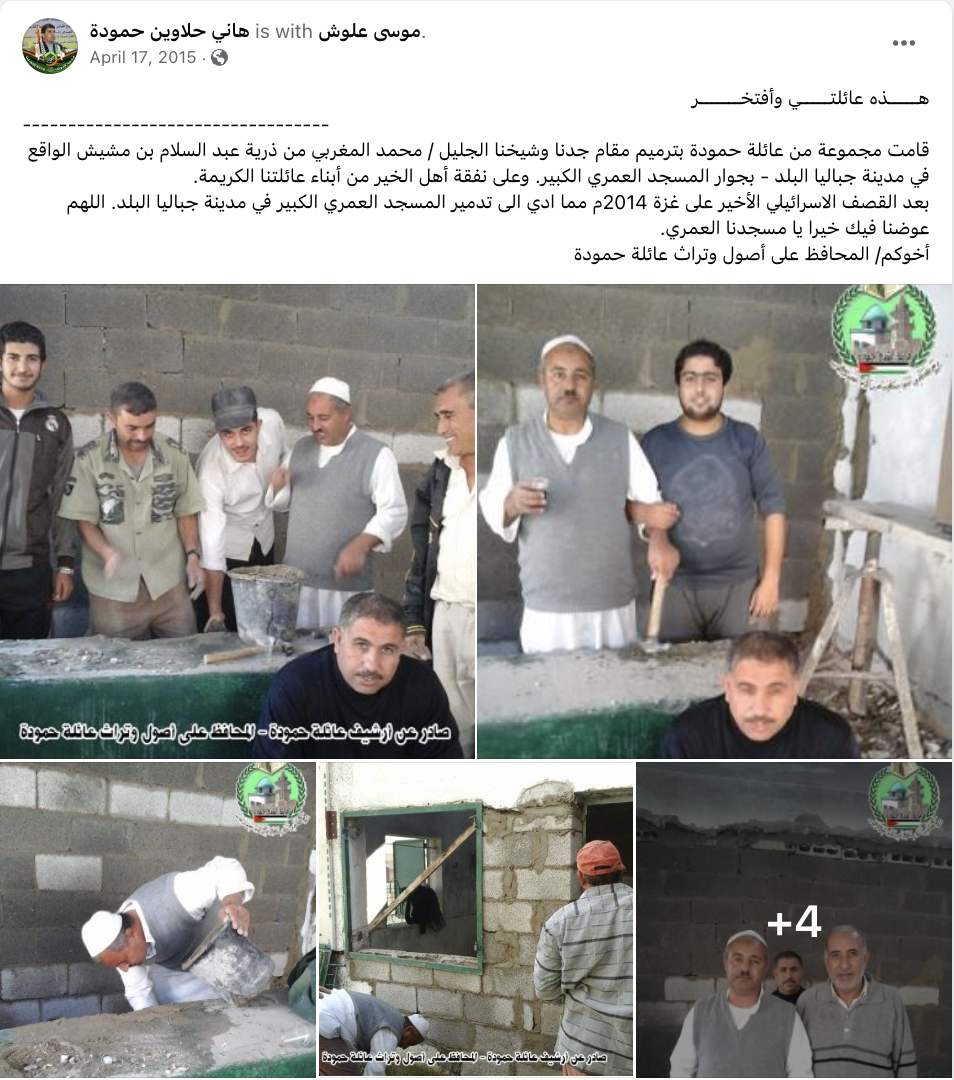
A Facebook post from 2015 shared by one of the residents in Jabalia announcing a self-financed initiative to repair and restore parts of the Al-Omari mosque after the Israeli state attacked in 2014.
In 2017, city residents took to social media platforms, expressing an outpouring of joy and optimism following the announcement of the start of the reconstruction of the Al-Omari Mosque. Photos shared on social media platforms showed the progress of the mosque’s restoration and the construction work, which gave hope of restoring life to the historical monument.
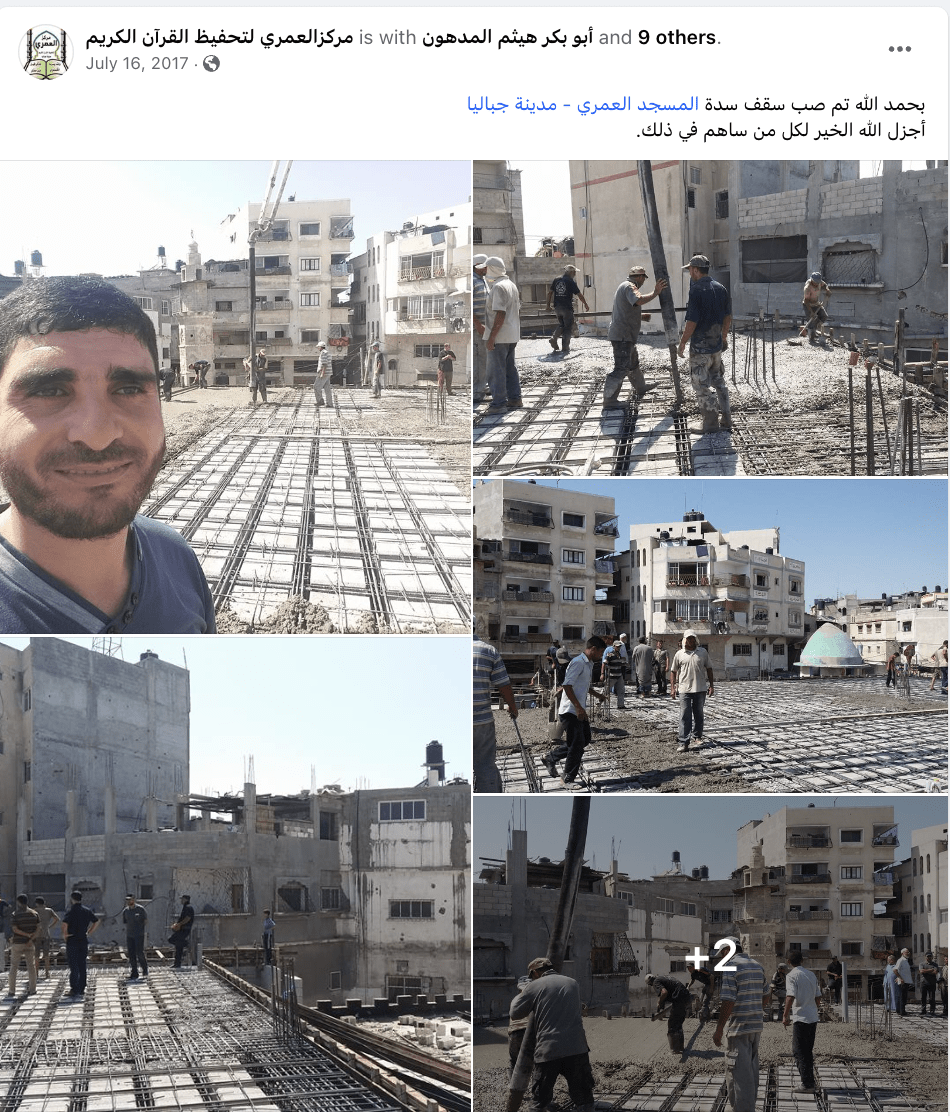
A screenshot of a Facebook post by Jabalia residents expressing joy and optimism following the start of reconstruction on the Al-Omari mosque in 2017.
In 2017, a Facebook post showed that efforts to rebuild the Al-Omari Mosque were carried out in response to a donation campaign launched by Gaza’s residents. This campaign was an expression of popular solidarity within the local community and contributed to the rehabilitation of the religious and historical landmark.
In 2019, the Al-Omari Mosque officially reopened with a ceremony, as shown in the circulated photos. The construction process was entirely funded by the people of the city, according to sources. The mosque was then destroyed again in the attacks in October of this year, adding a new chapter to the history of this site.
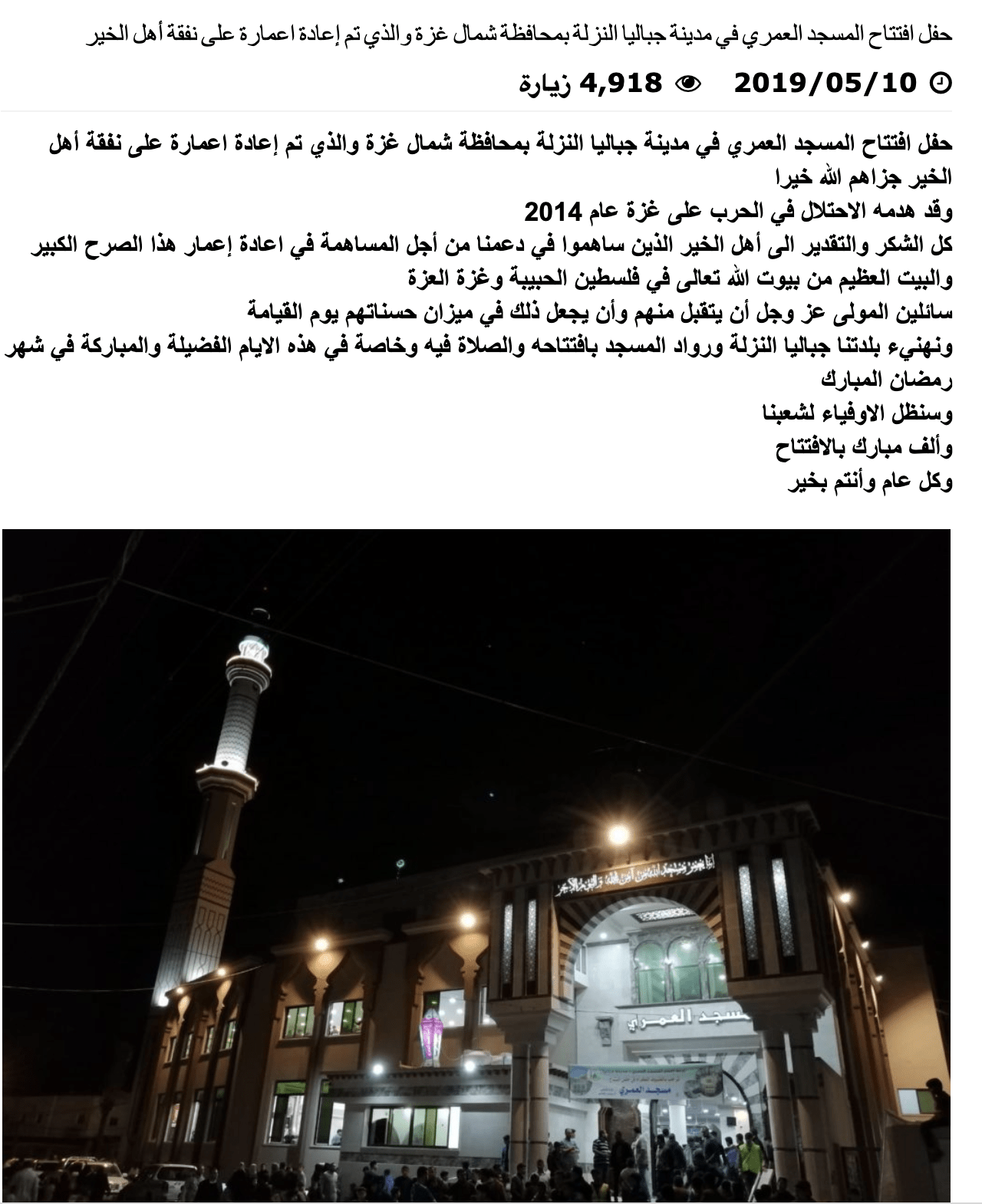
A screenshot from an article documenting the official reopening of the Al-Omari mosque in 2019.
International Treaties and Statements About the Attack on the Al-Omari Mosque
Considering the documented events of the attack on the Al-Omari Mosque, questions arise about adherence to international laws for the protection of cultural property in situations of armed conflict.
The 1954 Hague Convention and its Protocols stipulate that cultural property, including religious sites, must be protected from destruction and vandalism. Targeting these places, provided they remain outside the scope of military use, is a violation of this Convention. Under international law, attacks on objects that are not military targets and intentional destruction of cultural heritage may amount to violations that require further investigation and accountability.
In the context of addressing the recent events in Gaza, John Kirby, Coordinator for Strategic Communications at the U.S. National Security Council, conducted a press briefing during which he discussed the situation in Gaza. He was asked about the damage to the Roman Orthodox Church, which was described as one of the oldest landmarks in Gaza City, the targeting of Al-Omari Mosque, the subject of this investigation, and the repercussions of attacks targeting civilians and infrastructure. Kirby appeared uninterested and did not give a sufficient answer. He merely said that he would not comment on every incident that occurred on the ground and stressed that there had been clear communication with Israeli counterparts to ensure that operations were conducted in accordance with the laws of war. However, Kirby’s statements did not directly address cultural protection agreements or the auditing of compliance as stipulated in the Hague Convention and its Protocols. Kirby also did not address the intention to open independent investigations to uncover the circumstances of the attack on Al-Omari Mosque and provide the necessary evidence. These factors raise questions about the extent to which they are considered, within any framework, a priority for research and follow-up.
Methodology
Data collection: Photos and videos published on social media and news websites on the day of the attack and the following three days were collected, archived, and analyzed. Thirty different media sources were used in the investigation.
Time verification: The date and time of the attack were determined using advanced searches on Facebook (via WhoPostedWhat), X (formerly Twitter), and Telegram. We used diverse search engines as well as Invid, an open-source tool that extracts media date and time by reverse image search, to verify the information. We also used SunCalc, an open-source tool that determines the time photos were taken based on the length and direction of the shadows, to determine the date of images taken at the attack site. Results were consistent with the results of the first photos of the attack published on Facebook.
Verifying the geographical location: The geographical location of Al-Omari Mosque in Jabalia was determined by searching in Wikimapia, which contains more accurate data on the names of local areas than Google Maps and Google Earth. We then located the Great Omari Mosque, found in the Daraj Quarter, on the maps to prevent confusion between the two mosques.
Comparison: We matched video material posted by social media users showing the destruction of the Al-Omari Mosque in Jabalia with recent satellite images of the site as an additional layer of verification of information circulated in the media.
This investigation is the result of multiple stages of analysis of available open-source information of the date, time, and location of the attack.
By examining all available information about the attacks, this investigation provides a deeper understanding of the incident and corrects some of the relevant accounts. However, we could not determine the type of munition used nor the alleged party responsible for the attacks.
